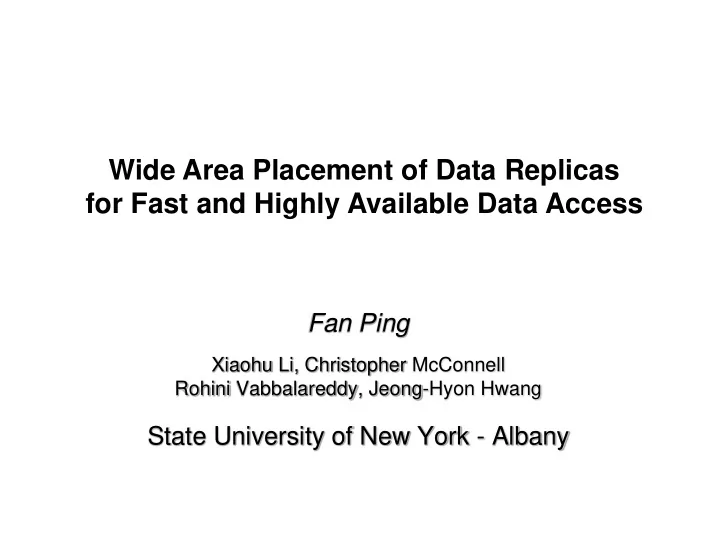

Wide Area Placement of Data Replicas for Fast and Highly Available Data Access Fan Ping Xiaohu Li, Christopher McConnell Rohini Vabbalareddy, Jeong-Hyon Hwang State University of New York - Albany
Outline • Background • Network Coordinate System • Data Replication - Data Replication for Performance - Data Replication for Performance and Availability • Conclusion
Outline • Background • Network Coordinate System • Data Replication - Data Replication for Performance - Data Replication for Performance and Availability • Conclusion
Data Intensive Distributed Systems • Google, Amazon, Facebook, Microsoft…
Data Intensive Distributed Systems • Google, Amazon, Facebook, Microsoft… • Dynamo, Cassandra, PNUTS…
Data Replica Placement • Given a replication degree (e.g., 3), where should we put those data replicas in order to effectively improve the overall data access speed and availability? • Challenges - Scalability - Certain SLA
Outline • Background • Network Coordinate System • Data Replication - Data Replication for Performance - Data Replication for Performance and Availability • Conclusion
Network Coordinate Systems - Based on the network latencies between each other, nodes are embedded into a virtual space so that their distances in this virtual space are close to the network latencies. - E.g., Vivaldi, RNP
Network Coordinate Systems
Network Coordinate Systems
Network Coordinate Systems
Network Coordinate Systems
Network Coordinate Systems
Network Coordinate Systems
Outline • Background • Network Coordinate System • Data Replication - Data Replication for Performance - Data Replication for Performance and Availability • Conclusion
Outline • Background • Network Coordinate System • Data Replication - Data Replication for Performance - Data Replication for Performance and Availability • Conclusion
Servers on the map
Servers in the coordinate system
Clients in the coordinate system
Cluster the clients in the coordinate system
Cluster the clients in the coordinate system
Centroids of the clusters
Servers near centroids of the clusters
Simulation Settings • Java simulator • ~200 Planetlab-node trace as input • A certain number of nodes are selected as servers • The other nodes are used as clients
Performance VS. Number of Replicas
Outline • Background • Network Coordinate System • Data Replication - Data Replication for Performance - Data Replication for Performance and Availability • Conclusion
Conditional Failure vs. Angle S1 R C S2
Conditional Failure vs. Angle S1 R 0.05% 0.05% C S2
Conditional Failure vs. Angle The conditional probability of the failure of (C, R, S 2 ) given the failure of (C,R,S 1 ) is more than 50% !! S1 R 0.05% 0.05% C S2
Conditional Failure vs. Angle S1 (30,35) C Ɵ S2 (0,-20) (-10,50)
Conditional Failure vs. Angle
Conditional Failure vs. Angle
Conditional Failure vs. Angle Ɵ
Conditional Failure vs. Angle
Estimations for Latency and Availability • Per-client latency L(c, S) = dist(c,s) • Per-client availability A(c,S) = 1- ( F(c,S 1 )*F(c,S 2 |S 1 )*…*F(c,S r |S r-1 ) ) • Utility function to combine latency and availability 𝑩 U = 𝑴
Simulation Settings • Java simulator • Traceroute and ping data collected from ~ 100 PlanetLab nods for a month • Randomly select some nodes as servers • The rest are clients
Unavailability vs. Number of Replicas
Outline • Background • Network Coordinate System • Data Replication - Data Replication for Performance - Data Replication for Performance and Availability • Conclusion
Conclusion and Future Work • Improves the average user access latency by 35% • Improves the overall availability • Designs the utility function to take into account both latency and availability • Needs more realistic dataset • Better utility function • Non- exponential algorithm (Greedy…) • Take inter-datacenter cost into account
Questions? THANK YOU!
Recommend
More recommend